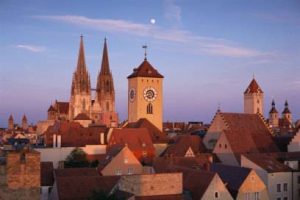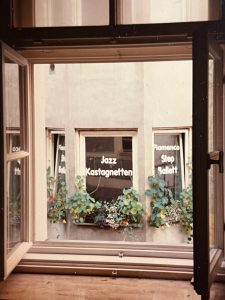Regensburg: Rapunzel in the Golden Tower
by Pauline Park
I have lived in 10 different cities in five different countries: Milwaukee, Madison, Chicago, Champaign-Urbana and New York (both on Staten Island and in Queens) in the United States and London (England), Berlin (Germany), Belgium (Brussels) and France (Paris); by far the most extraordinary of any of my domiciles was the Goldener Turm, a 12th century tower I lived in during my six weeks in Regensburg in the summer of 1991. Founded by the Romans as Ratisbona and consequently known to the French as ‘Ratisbon,’ Regensburg occupies a strategic position at the westernmost point on the Danube which larger ships find navigable and as a result has attracted commerce over the centuries and tourism in more recent decades (“7 gute Gründe für einen Besuch in Regensburg,” Travelbook, 4 December 2015).
How I came to live in a medieval tower in Bavaria itself is a story worth telling. In preparing for my dissertation research on the Maastricht Treaty that created the European Union, I took four semesters of German at the University of Illinois at Urbana-Champaign, where I was doing my Ph.D. I had studied German in junior high and high school, but I had ineffective teachers and unengaged fellow students and so really learned little except perhaps good pronunciation (my junior high school German teacher was a German immigrant). To fund summer study in Germany, I applied for a fellowship through the Deutscher Akademischer Austausch Dienst (DAAD) and won a fellowship to study German and cognate subjects at the Universität Regensburg.
The DAAD fellowship was a great prize, but even greater was the Fulbright fellowship I won — in the process, becoming the first student at any University of Illinois campus to win a Fulbright fellowship for France. After careful consideration, I decided to spend the summer in Regensburg and the fall in Brussels, where I was generously given a desk and an office at the Centre for European Policy Studies (CEPS); I would leave Brussels at the end of December, moving down to Paris for six months to finish my dissertation research.
In Brussels in August 1991, I would revive my French, as I had revived my German at the Goethe-Institut Berlin in September and October 1990, and my German language course at the Universität Regensburg in June and July 1991 would greatly enhance my German proficiency; I felt that with French and German — along with my native English — I would be proficient in the three most important EU languages; little did I know at the time that most ‘Eurocrats’ and diplomats in Brussels spoke English — albeit in many cases, a Brussels Eurocrat English full of EU-specific neologisms. However, I did end up conducting at least one interview in German at the Bundeskanzleramt in Bonn and one in French at the Quai d’Orsay — which earned me a compliment from a French diplomat — and the enhanced French and German were certainly useful for reading documents.
In truth, the intensive language study of the early 1990s was followed by years in which I used neither French nor German; ironically, it was the extreme Francophobia of the administration of George W. Bush and Republican members of Congress that prompted me — ‘provoked’ me, I’m tempted to say — in the lead-up to the Iraq War in 2003 to revive my French. The revival of my German would come much later, when I took four courses at NYU’s Deutsches Haus in Manhattan in 2018, 2019 and 2020. Reviving my German over the course of those four semesters brought me full circle in many ways: not only did it remind me of my six weeks in Regensburg in 1991 and my two months in Berlin in 1990, the fourth of those four courses was taught by a Bavarian — who actually did not grow up speaking Bairisch because her father was a Polish immigrant and so he spoke standard Hochdeutsch (High German) with his Bavarian wife.
By the end of my six weeks in Regensburg, my Hochdeutsch had become quite good and I spoke it with everyone — neither understanding nor speaking the Bavarian dialect — which is so different from standard High German. Der Goldener Turm is in the heart of Regensburg — which has the best preserved medieval old town of any city in Bavaria and possibly in all of Germany; the university had very cleverly converted the two floors of the ‘annex’ (built in 1527) to dormitory space for students and I had a small but exceptionally clean room in the annex — whose date of construction I knew because it was painted on the wall of the common room. The showers and kitchen were also thankfully modern and extremely efficient, but the narrow lane that separated the Golden Tower from the building across the way was so narrow that when I opened my window, I could look directly into the dance studio across the way; at one point, one of the instructors became so perturbed that she closed the windows to the dance studio as she was conducting a class in what appeared to be jazz dance; I wanted to tell her that it was hardly my fault that the medieval lane separating the two buildings was so narrow as to make real privacy impossible when my windows were open at the same time as the dance studios~!
But unlike Rapunzel in the Grimmsmärchen of the Gebrüder Grimm, I did not have to let down my golden hair to exit the Golden Tower: my room was on the second floor, and in any case, my hair was never blond and never that long. Living in Regensburg’s medieval Altstadt was an extraordinary experience nonetheless and sometimes felt a bit as if I were living in a Grimmsmärchen; perhaps the strongest such feeling I had was the day I arrived in Regensburg, having taken a train from Frankfurt; Germans often call Germany’s financial capital ‘Bankfurt’ and the cathedral and the medieval city hall are almost all that is left of the old city that otherwise was completely destroyed by Allied bombing during World War II. Entering Regensburg’s medieval Standzentrum for the first time felt almost like entering a dream world and wandering its narrow lanes at night, I felt an air of mystery that is difficult to describe. While I was happy to move onto Brussels in August to begin my dissertation research in earnest, I will always treasure the memories of my six weeks living in the Goldener Turm in the midst of the medieval splendor of Regensburg’s mittelalterliche Altstadt.

